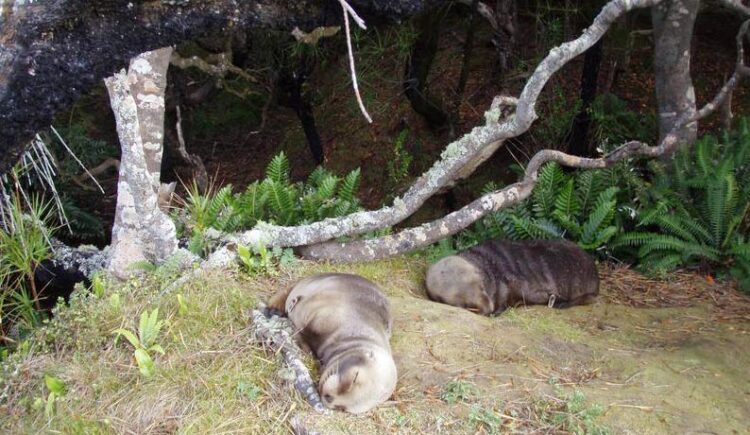New models help welcome the world’s rarest sea lion as they return home

Das Aufspüren junger Neuseeland-Seelöwen im Wald ist nicht so leicht wie es aussieht.
© Amélie Augé
After 200 years of absence due to historic human pressures that once threatened their existence, New Zealand sea lions are returning to New Zealand’s mainland in an emerging story of conservation success and complex opportunities.
Dr. Jan O. Engler, a post-doctorate at Chair for Computational Landscape Ecology at Technische Universität Dresden, joined an international team of ecologists and conservationists to map suitable habitats for these endangered New Zealand sea lions and help managers welcome them home. Led by Michigan State University PhD student Veronica Frans, the work, published in this month’s issue of Methods in Ecology and Evolution.
The Integrated Species Distribution Model Database (iSDMdb), developed by Frans, Engler, and colleagues, is an informative map that assists managers in finding these potential locations in the breeding season, but also helps with another complication: humans.
The sea lions’ unique behaviors make conservation efforts for them a little more complicated. Breeding female New Zealand sea lions are the only sea lions on the planet that you can find up to 2 km away from the coast, in forests. While you can still find them on the beach when pups are first born, these moms bring their pups inland to protect them from wind, storms, and being bothered by young males. As their populations are returning, “it’s one thing for wildlife rangers to look out for sea lions on sandy beaches, but it’s another challenge for them to tromp through forests to find baby sea lions hiding under the trees,” said Frans. “While we can’t know for sure where female sea lions will go on the mainland, we can use models to make helpful predictions.”
While finding sea lion pups in forests may sound like a treat, sea lion moms are actually quite protective of their pups, and encounters can be dangerous for both the sea lions and people. They have been hit by cars and killed deliberately. They have also had bad encounters with pets, been found snoozing at children’s parks or enjoying a local swimming pool, and have given birth in people’s back yards. Fences, roads, and residential areas can also be barriers as moms try to move their pups into the forests.
By working closely with managers, rangers, and decision-makers at the New Zealand Department of Conservation, this new database helps address these concerns for future conservation planning and community outreach. The database takes the form of an interactive map that is available to the public to be used to identify potential hazards and explore new habitats to make way for these sea lions as they return home.
“This project not only has great management applications for the sea lions, but it also demonstrates that complicated models really can be translated into real-world use,” says Dr. Engler, senior author of this study. “Scientists have been saying for years that these species distribution models need an upgrade for conservationists, and this work is a successful example of how that can be done.”
In addition to Frans and Engler, “Integrated SDM database: Enhancing the relevance and utility of species distribution models in conservation management” was written by Amélie Augé, Jim Fyfe, Yuqian Zhang, Nathan McNally, Hendrik Edelhoff, and Niko Balkenhol. The article is published open access and has been made available on Nov. 8th 2021 at Methods in Ecology and Evolution.
Wissenschaftliche Ansprechpartner:
Dr. Jan O. Engler
TU Dresden / Chair of Computational Landscape Ecology
Email: Jan_Oliver.Engler@tu-dresden.de
Media Contact
All latest news from the category: Ecology, The Environment and Conservation
This complex theme deals primarily with interactions between organisms and the environmental factors that impact them, but to a greater extent between individual inanimate environmental factors.
innovations-report offers informative reports and articles on topics such as climate protection, landscape conservation, ecological systems, wildlife and nature parks and ecosystem efficiency and balance.
Newest articles

High-energy-density aqueous battery based on halogen multi-electron transfer
Traditional non-aqueous lithium-ion batteries have a high energy density, but their safety is compromised due to the flammable organic electrolytes they utilize. Aqueous batteries use water as the solvent for…

First-ever combined heart pump and pig kidney transplant
…gives new hope to patient with terminal illness. Surgeons at NYU Langone Health performed the first-ever combined mechanical heart pump and gene-edited pig kidney transplant surgery in a 54-year-old woman…

Biophysics: Testing how well biomarkers work
LMU researchers have developed a method to determine how reliably target proteins can be labeled using super-resolution fluorescence microscopy. Modern microscopy techniques make it possible to examine the inner workings…





















